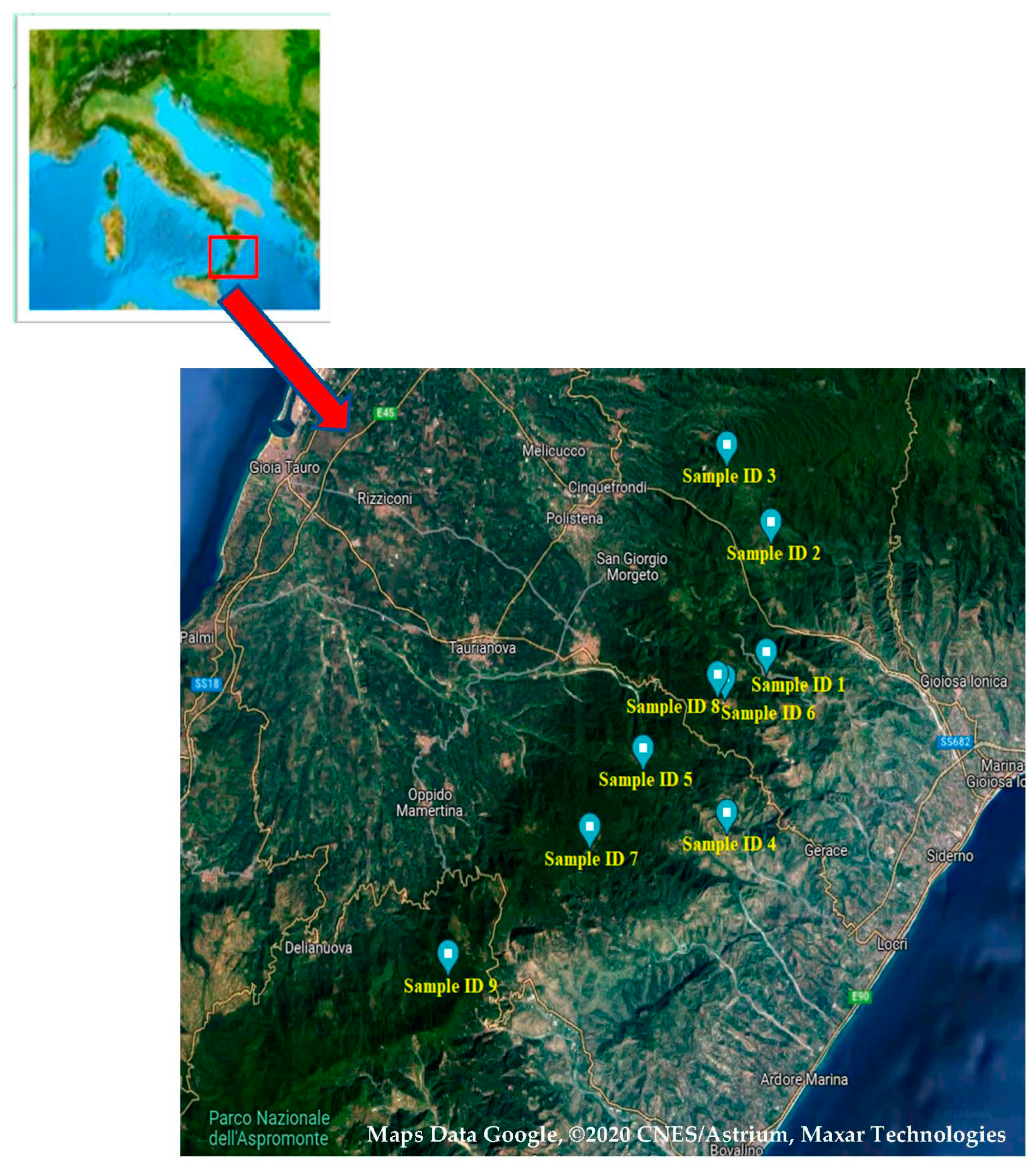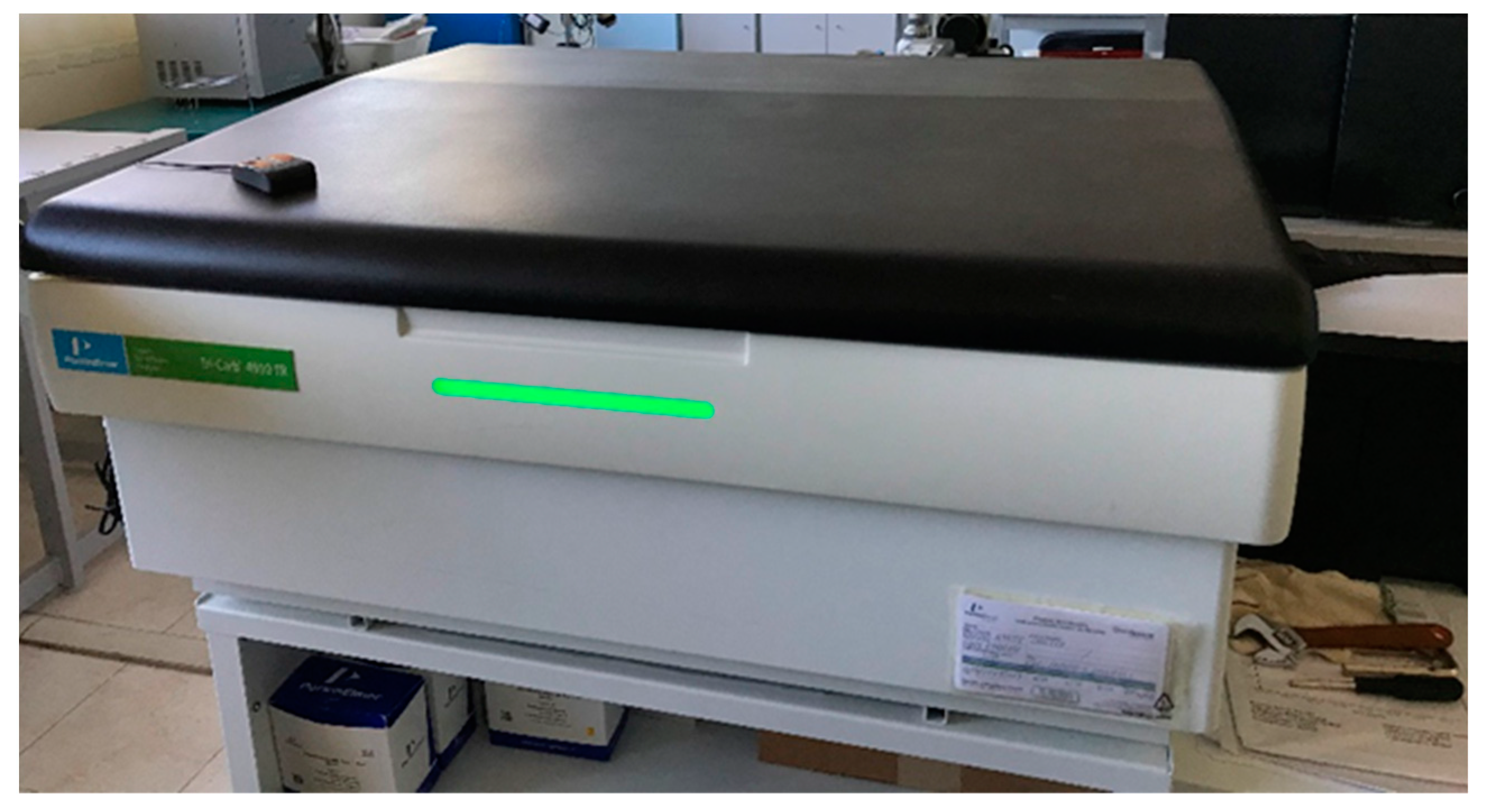Radon-Specific Activity in Drinking Water and Radiological Health Risk Assessment: A Case Study
Abstract
:1. Introduction
2. Materials and Methods
2.1. Sample Collection
2.2. Liquid Scintillation Counting (LSC) Measurements
2.3. Evaluation of the Radiological Health Risk
3. Results and Discussion
4. Conclusions
Author Contributions
Funding
Institutional Review Board Statement
Informed Consent Statement
Data Availability Statement
Conflicts of Interest
References
- Reino, W.; Pucha, G.; Recalde, C.; Tene, T.; Cadena, P. Occurrence of radioactive materials in pyroclastic flows of Tungurahua volcano using gamma spectrometry. AIP Conf. Proc. 2018, 2003, 1–7. [Google Scholar] [CrossRef]
- Caridi, F.; Marguccio, S.; Durante, G.; Trozzo, R.; Fullone, F.; Belvedere, A.; D’Agostino, M.; Belmusto, G. Natural radioactivity measurements and dosimetric evaluations in soil samples with a high content of NORM. Eur. Phys. J. Plus 2017, 132, 56. [Google Scholar] [CrossRef]
- Kerur, B.; Tanakanti, R.; Basappa, D.; Kumar, A.; Narayani, K.; Rekha, A.; Hanumaiah, B. Radioactivity levels in rocks of North Karnataka, India. Indian J. Pure Appl. Phys. 2010, 48, 809–812. [Google Scholar]
- Baeza, A.; Salas, A.; Legarda, F. Determining factors in the elimination of uranium and radium from groundwaters during a standard potabilization process. Sci. Total Environ. 2008, 406, 24–34. [Google Scholar] [CrossRef]
- Ravisankar, R.; Vanasundari, K.; Chandrasekaran, A.; Rajalakshmi, A.; Suganya, M.; Vijayagopal, P.; Meenakshisundaram, V. Measurement of natural radioactivity in building materials of Namakkal, Tamil Nadu, India using gamma-ray spectrometry. Appl. Radiat. Isot. Incl. data Instrum. Methods Use Agric. Ind. Med. 2012, 70, 699–704. [Google Scholar] [CrossRef]
- Ravisankar, R.; Chandramohan, J.; Chandrasekaran, A.; Prince Prakash Jebakumar, J.; Vijayalakshmi, I.; Vijayagopal, P.; Venkatraman, B. Assessments of radioactivity concentration of natural radionuclides and radiological hazard indices in sediment samples from the East coast of Tamilnadu, India with statistical approach. Mar. Pollut. Bull. 2015, 97, 419–430. [Google Scholar] [CrossRef] [PubMed]
- Alabdula’aly, A.I.; Maghrawy, H.B. Radon emanation from radium specific adsorbents. Water Res. 2010, 44, 177–184. [Google Scholar] [CrossRef]
- Mottese, A.F.; Fede, M.R.; Caridi, F.; Sabatino, G.; Marcianò, G.; Calabrese, G.; Albergamo, A.; Dugo, G. Chemometrics and innovative multidimensional data analysis (MDA) based on multi-element screening to protect the Italian porcino (Boletus sect. Boletus) from fraud. Food Control 2020, 110, 107004. [Google Scholar] [CrossRef]
- Albergamo, A.; Mottese, A.F.; Bua, G.; Caridi, F.; Sabatino, G.; Barrega, L.; Costa, R.; Dugo, G. Discrimination of the Sicilian Prickly Pear (Opuntia Ficus-Indica L., CV. Muscaredda) According to the Provenance by Testing Unsupervised and Supervised Chemometrics. J. Food Sci. 2018, 83, 2933–2942. [Google Scholar] [CrossRef]
- Azeez, H.; Mohammed, M.; Abdullah, G. Measurement of radon concentrations in rock samples from the Iraqi Kurdistan Region using passive and active methods. Arab. J. Geosci. 2021, 14, 572. [Google Scholar] [CrossRef]
- Faanu, A.; Adukpo, O.K.; Tettey-Larbi, L.; Lawluvi, H.; Kpeglo, D.O.; Darko, E.O.; Emi-Reynolds, G.; Awudu, R.A.; Kansaana, C.; Amoah, P.A.; et al. Natural radioactivity levels in soils, rocks and water at a mining concession of Perseus gold mine and surrounding towns in Central Region of Ghana. Springerplus 2016, 5, 98. [Google Scholar] [CrossRef] [PubMed]
- Raja, S.L.; Marpaung, H.; Simanjuntak, S.; Simanjuntak, C.; Pudjadi, E. Distribution and risk assessment of natural radioactive elements in volcanic ashes, cold lava, river waters due to volcanic eruption of Mount Sinabung. In AIP Conference Proceedings; AIP Publishing: Melville, NY, USA, 2021; Volume 2342. [Google Scholar] [CrossRef]
- Moreno, V.; Bach, J.; Baixeras, C.; Font, L. Radon levels in groundwaters and natural radioactivity in soils of the volcanic region of La Garrotxa, Spain. J. Environ. Radioact. 2014, 128, 1–8. [Google Scholar] [CrossRef] [PubMed]
- Todorovic, N.; Nikolov, J.; Forkapic, S.; Bikit, I.; Mrdja, D.; Krmar, M.; Veskovic, M. Public exposure to radon in drinking water in Serbia. Appl. Radiat. Isot. Incl. data Instrum. Methods Use Agric. Ind. Med. 2012, 70, 543–549. [Google Scholar] [CrossRef] [PubMed]
- Suleiman, A.; Futua, I.; Dewu, B.; Kwaya, M.; Kurowska, E.; Muhammad, M.; GARBA, M. NORM, radon emanation kinetics and analysis of rocks-associated radiological hazards. Environ. Earth Sci. 2016, 75, 1–9. [Google Scholar] [CrossRef]
- Torrisi, L.; Caridi, F.; Giuffrida, L. Protons and ion acceleration from thick targets at 1010 W/cm2 laser pulse intensity. Laser and Part. Beams. 2011, 29, 29–37. [Google Scholar] [CrossRef]
- Mulec, J.; Petrič, M.; Koželj, A.; Brun, C.; Batagelj, E.; Hladnik, A.; Holko, L. A multiparameter analysis of environmental gradients related to hydrological conditions in a binary karst system (underground course of the Pivka River, Slovenia). Acta Carsologica 2019, 48, 1–15. [Google Scholar] [CrossRef]
- Lerman, A. Geochemical Processes: Water and Sediment Environments/A. Lerman; Wiley: New York, NY, USA, 1979; ISBN 0471032638. [Google Scholar]
- Trautmannsheimer, M.; Schindlmeier, W.; Hübel, K. Radon exposure levels of the staff in the drinking water supply facilities in Bavaria, Germany. Int. Congr. Ser. 2002, 1225, 81–86. [Google Scholar] [CrossRef]
- United Nations Scientific Committee on the Effects of Atomic Radiation. Sources and Effects of Ionizing Radiation: Report to the General Assembly, with Scientific Annexes; United Nations Scientific Committee on the Effects of Atomic Radiation: Vienna, Austria, 2000; Volume I, ISBN 92-1-142238-8. [Google Scholar]
- Love, S.K. Natural Radioactivity of Water. Ind. Eng. Chem. 1951, 43, 1541–1544. [Google Scholar] [CrossRef]
- Hendry, J.H.; Simon, S.L.; Wojcik, A.; Sohrabi, M.; Burkart, W.; Cardis, E.; Laurier, D.; Tirmarche, M.; Hayata, I. Human exposure to high natural background radiation: What can it teach us about radiation risks? J. Radiol. Prot. 2009, 29, A29–A42. [Google Scholar] [CrossRef]
- Caridi, F.; Messina, M.; Belvedere, A.; D’Agostino, M.; Marguccio, S.; Settineri, L.; Belmusto, G. Food salt characterization in terms of radioactivity and metals contamination. Appl. Sci. 2019, 9, 2882. [Google Scholar] [CrossRef]
- Italian Legislation D. Lgs. n. 28/2016. Available online: https://www.gazzettaufficiale.it/eli/id/2016/03/07/16G00036/sg (accessed on 3 July 2023).
- Caridi, F.; Messina, M.; D’Agostino, M. An investigation about natural radioactivity, hydrochemistry, and metal pollution in groundwater from Calabrian selected areas, southern Italy. Environ. Earth Sci. 2017, 76, 668. [Google Scholar] [CrossRef]
- ISO 13164-1:2013. 2013. Available online: https://www.iso.org/obp/ui/en/#iso:std:iso:13164:-1:ed-1:v2:en (accessed on 3 July 2023).
- ISO 13164-4:2015. 2015. Available online: https://www.iso.org/standard/62424.html (accessed on 3 July 2023).
- Forte, M.; Rusconi, R.; Cazzaniga, M.; Sgorbati, G. The measurement of radioactivity in drinking water. Microchem. J. 2007, 105, 98–102. [Google Scholar] [CrossRef]
- Perkin Elmer Perkin-Elmer Tricarb 4910 TR User Manual. 2012. Available online: https://cdn.vanderbilt.edu/vu-web/lab-wpcontent/sites/20/2018/05/22193208/TriCarb-Family-Manual.pdf (accessed on 4 July 2023).
- Forte, M.; Bertolo, A.; D’Alberti, P.; De Felice, P.; Desideri, D.; Esposito, M. Standardised methods for measuring radionuclides in drinking water. In Proceedings of the 8th International Conference on Nuclear Analytical Methods in the Life Sciences, Rio de Janeiro, Brazil, 17–22 April 2005. [Google Scholar]
- ACCREDIA. Available online: https://www.accredia.it/ (accessed on 4 July 2023).
- Abdullah, G.; Azeez, H.; Mustafa, H.; Ismaeel, A. A study of radon concentration and physicochemical parameters in spring water of Erbil city, Iraqi Kurdistan Region. J. Radioanal. Nucl. Chem. 2023, 332, 775–784. [Google Scholar] [CrossRef]
- European Food Safety Authority (EFSA). Scientific opinion on the public health hazards to be covered by inspection of meat from farmed game. EFSA J. 2013, 11, 32641–32681. [Google Scholar]
- Matsumoto, M.; Yasuoka, Y.; Takakaze, Y.; Hosoda, M.; Tokonami, S.; Iwaoka, K.; Mukai, T. Evaluation of radon concentration measurements in water using the radon degassing method. J. Radioanal. Nucl. Chem. 2023, 332, 167–172. [Google Scholar] [CrossRef]
- IAEA. Extent Of Environmental Contamination By Naturally Occurring Radioactive Material (Norm) And Technological Options For Mitigation; International Atomic Energy Agency: Vienna, Austria, 2003; pp. 1–208. [Google Scholar]
- Morelli, D.; Immé, G.; Cammisa, S.; Catalano, R.; Mangano, G.; La Delfa, S.; Patanè, G. Radioactivity measurements in volcano-tectonic area for geodynamic process study. In Proceedings of the European Physical Journal Web of Conferences, Rome, Italy, 25–27 October 2010. [Google Scholar]
- Atzori, P.; Ferla, P.; Paglionico, A.; Piccarreta, G.; Rottura, A. Remnants of the Hercynian orogen along the “Calabrian-Peloritan arc”, southern Italy: A review. J. Geol. Soc. Lond. 1984, 141, 137–145. [Google Scholar] [CrossRef]
- EURATOM. 2001/928/Euratom—RACCOMANDAZIONE DELLA COMMISSIONE del 20 dicembre 2001 sulla tutela della popolazione contro l’esposizione al radon nell’acqua potabile. Gazz. Uff. delle Comunità Eur. 2001, 928, 85–88. [Google Scholar]
- WHO. Indoor Radon a Public Health Perspective; WHO: Geneva, Switzerland, 2007; p. 110. [Google Scholar]


| Site ID | GPS Coordinates | |
|---|---|---|
| Latitude | Longitude | |
| 1 | 38°21′03.0″ N | 16°10′35.0″ E |
| 2 | 38°23′39.1″ N | 16°11′17.3″ E |
| 3 | 38°25′30.8″ N | 16°09′41.5″ E |
| 4 | 38°16′42.4″ N | 16°09′46.7″ E |
| 5 | 38°18′17.4″ N | 16°06′40.2″ E |
| 6 | 38°19′57.4″ N | 16°09′37.1″ E |
| 7 | 38°16′24.7″ N | 16°04′47.3″ E |
| 8 | 38°20′00.5″ N | 16°09′20.7″ E |
| 9 | 38°13′24.4″ N | 15°59′43.8″ E |
| Site ID | CRn-222 (Bq L−1) |
|---|---|
| 1 | 164 ± 46 |
| 2 | 7.4 ± 1.4 |
| 3 | 13.1 ± 2.4 |
| 4 | 9.1 ± 1.6 |
| 5 | 76 ± 18 |
| 6 | 38.9 ± 8.3 |
| 7 | 15.5 ± 2.8 |
| 8 | 64 ± 15 |
| 9 | 32.4 ± 6.6 |
Disclaimer/Publisher’s Note: The statements, opinions and data contained in all publications are solely those of the individual author(s) and contributor(s) and not of MDPI and/or the editor(s). MDPI and/or the editor(s) disclaim responsibility for any injury to people or property resulting from any ideas, methods, instructions or products referred to in the content. |
© 2023 by the authors. Licensee MDPI, Basel, Switzerland. This article is an open access article distributed under the terms and conditions of the Creative Commons Attribution (CC BY) license (https://creativecommons.org/licenses/by/4.0/).
Share and Cite
Caridi, F.; Paladini, G.; D’Agostino, M.; Marguccio, S.; Belvedere, A.; Belmusto, G.; Stilo, G.; Majolino, D.; Venuti, V. Radon-Specific Activity in Drinking Water and Radiological Health Risk Assessment: A Case Study. Appl. Sci. 2023, 13, 9660. https://doi.org/10.3390/app13179660
Caridi F, Paladini G, D’Agostino M, Marguccio S, Belvedere A, Belmusto G, Stilo G, Majolino D, Venuti V. Radon-Specific Activity in Drinking Water and Radiological Health Risk Assessment: A Case Study. Applied Sciences. 2023; 13(17):9660. https://doi.org/10.3390/app13179660
Chicago/Turabian StyleCaridi, Francesco, Giuseppe Paladini, Maurizio D’Agostino, Santina Marguccio, Alberto Belvedere, Giovanna Belmusto, Giovanna Stilo, Domenico Majolino, and Valentina Venuti. 2023. "Radon-Specific Activity in Drinking Water and Radiological Health Risk Assessment: A Case Study" Applied Sciences 13, no. 17: 9660. https://doi.org/10.3390/app13179660
APA StyleCaridi, F., Paladini, G., D’Agostino, M., Marguccio, S., Belvedere, A., Belmusto, G., Stilo, G., Majolino, D., & Venuti, V. (2023). Radon-Specific Activity in Drinking Water and Radiological Health Risk Assessment: A Case Study. Applied Sciences, 13(17), 9660. https://doi.org/10.3390/app13179660












